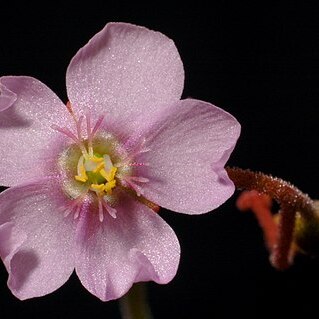Leaves in basal rosettes; lamina 0·4–2·0 x 0·2–1·1 cm., obovate-spathulate, glandular; stipules 0·2–0·5 cm. long, connate at the base, apex lacerated; petioles 0·4–1·5 cm. long, broadening into the lamina, sparsely to densely pilose.
Small herb with basal, rosulate leaves inserted close together on very short stem. Style arms bifid or trifid. Rosette lax, old leaves not long persistent, blade thin, sparsely covered with tentacles. Flowers brown and pink.
Inflorescence racemose, 3–13-flowered; pedicels 1–9 mm. long, glandular; bracts 1–2 mm. long, linear-elliptic, caducous.
Peduncles 1–2, 10–45 cm. long, arising laterally from the rosette then curving to become erect, canaliculate, glandular.
Sepals 5, 3–6 x 2–2·5 mm., connate at the base, ± elliptic, irregularly serrulate at the apex, glandular.
Ovary subglobose, glabrous; styles 3, 1 mm. long, 2-partite to the base with 2-fid apices.
Seeds 0·4–0·6 x 0·1–0·2 mm., black, ellipsoid-fusiform, testa more or less foveolate.
Petals 5, 7–8 mm. long, white to pink.
Stamens 5, filaments 3 mm. long.
Perennial herb, acaulescent.

